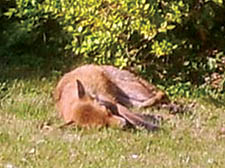|
|
 |
| |

‘The fox poses no threat to humans and brings pleasure to thousands’ |
Deterrence, not destruction, is the answer to our urban foxes
Following a spate of alleged attacks by foxes on domestic cats in Gospel Oak, John Bryant explains ways of living in harmony with ‘Basil Brush’
FOXES have been breeding in Greater London for more than 60 years and the adult population now appears to be settled at around 10,000.
A pair of urban foxes establish a territory of say 150 to 200 gardens, which they defend from incursion by other foxes by ‘scent-marking’ with their urine and faeces.
They rear, on average, a family of four cubs, which disperse in the autumn or early winter.
Killing foxes (or worse, capturing and dumping them elsewhere) is pointless because vacant territories are filled within days by other foxes.
Government and councils in London spent millions of pounds trying to rid the capital of foxes from the 1940s up until the 1980s, with the result that there were more foxes than when they started.
So, there’s no point in killing or removing them; deterrence is the only logical solution.
Foxes are not dangerous to humans – there is no authenticated case of a fox ever attacking a human being (compared with hundreds of thousands of dog attacks on people in the UK every year) – and there is no risk of the public contracting a disease from foxes. Polls show that 80 per cent of Londoners are happy to share the city with foxes.
Foxes can be a nuisance, of course, with fouling, digging and screaming, but these problems are often seasonal and can be countered with proven deterrence techniques.
One of the major questions is, “Do foxes kill cats?” The answer is yes. But then it is also a fact that cats kill fox cubs.
Fortunately, both occurrences are rare.
Bristol University’s research shows that, statistically, a fox could be expected to kill a cat once every five years, and as very few foxes survive more than two years, it is clear that most foxes never kill a cat.
They will scavenge dead cats from roads, and even dig up dead cats, but most foxes don’t want to risk a scrap with a live one.
In my experience the only period of slight risk is in the period of February to May if a cat gets too close to young cubs.
I have known a few cases where an adult fox has confronted a cat approaching a den containing cubs, and instead of ‘fluffing-up’ and spitting defiance, the cat made the mistake of turning tail and running for home.
This invited the fox to chase, and I have dealt with cases where the cat has been bitten in the tail or back legs before reaching safety.
Risk can be reduced further by keeping the cat in at night.
More at risk are pets such as rabbits and guinea-pigs. These animals are natural prey for all predators and owners have a legal duty to keep them in predator-
proof accommodation.
Standard pet shop hutches are useless. Hutches should be sturdy, padlocked, and fixed to a wall at around four feet high. Such pets should never be allowed to run freely around the garden unless constantly supervised. Even going inside to make a cup of tea could result in tragedy
The fact is, foxes are native to Britain and pose no risk to humans. They can be a nuisance, but on the other hand they bring pleasure into the lives of thousands of people.
Bearing in mind mankind’s cruel and massive destruction of wildlife the world over, surely we can tolerate our urban Basil Brush.
|
 |
|
|
 |
|
 |
|